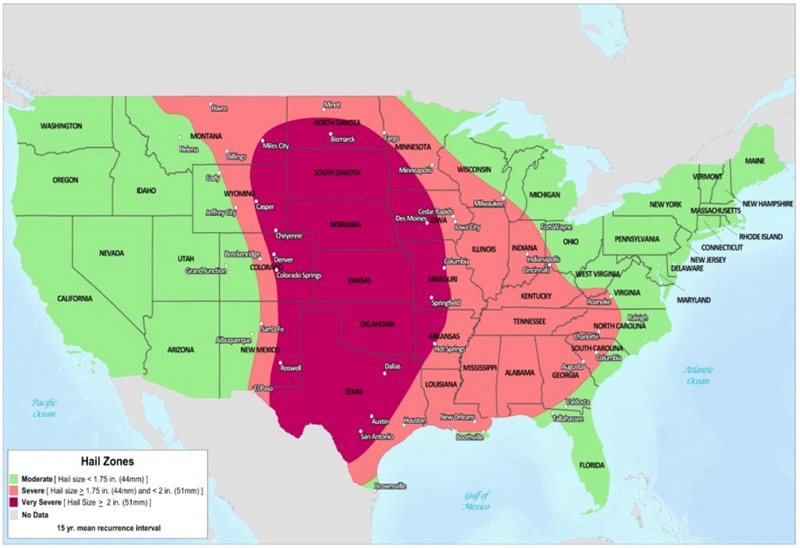FM’s VSH Testing – Very Severe Hail
FM Global, a leading commercial building insurer, and its code-approved testing agency subsidiary, FM Approvals, have created a Very Severe Hail (VSH) impact resistance classification that could affect design professionals.
FM Global Guidelines
Traditionally, FM Global has recommended its insured building owners use moderate hail (MH) and severe hail (SH) classified roof systems for buildings located in areas FM Global considers to be susceptible to moderate or severe hail impacts. FM Loss Prevention Data Sheet 1-34 ("Hail Damage") provides a map identifying these regions. In recent years, the insurance industry in the United States has seen an uptick in losses from hail in terms of the number of claims experienced and costs of those claims. A majority of the hail damage occurs to roof systems and other rooftop components.
In the latest version of FM 1-34 (April 2019), FM Global identified a new VSH region encompassing Oklahoma, Kansas, Nebraska, South Dakota, most of Texas, and parts of Montana, North Dakota, Minnesota, Iowa, Missouri, Arkansas, Wyoming, Colorado, and New Mexico.

Per FM Global, this area was classified as a VSH region based on data from the National Oceanic and Atmospheric Administration's National Weather Service and National Center for Environmental Protection's Storm Prediction Center. This data shows a concentration of reports of hail greater than 2 inches in diameter in this geographical region.
Until recently, FM Approvals did not have VSH-classified roof systems available to satisfy its recommendation in the VSH region. In the interim, FM 1-34 recommended using assemblies tested to a Class 4 rating using FM 4473 ("Specification Test Standard for Impact Resistance Testing of Rigid Roofing Materials by Impacting with Freezer Ice Balls").
FM 1-34 indicates aggregate- and paver-ballasted roof systems can be substituted for MH- and SH-classified roof systems in the MH and SH regions. However, FM Global restricts the use of aggregate-ballasted roof systems on buildings taller than 150 feet, or in areas where the design wind speed is 100 miles per hour or greater.
FM has indicated only paver-surfaced roof systems can be substituted for a VSH-classified roof system.
FM 1-34 also contains recommendations for skylights, rooftop HVAC equipment, and other critical outdoor equipment in the MH, SH, and VSH regions.
Hail Classifications
FM Approvals traditionally has tested and classified membrane roof systems for MH and SH impact resistances using FM 4470 ("Approval Standard for Single-Ply, Polymer-Modified Bitumen Sheet, Built-Up Roofs (BUR) and Liquid Applied Roof Assemblies for use in Class 1 and Noncombustible Roof Deck Construction). This is the same test method on which many FM Approvals roof system classifications are based.
Using FM 4470's procedure, MH-classified roof systems withstand a 2-inch-diameter steel ball weighing 1.19 pounds dropped from a height of 81 inches in a section of tubing. This results in an impact energy of about 8 foot-pounds (ft-lbs.) on the surface of the roof system test specimen.
SH-classified roof systems withstand the same 2-inch-diameter steel ball dropped from a height of 141.5 inches, resulting in an impact energy of about 14 ft-lbs. on the surface of the roof system test specimen.
FM Approvals recently updated its impact-resistance test method to include testing for the VSH classification. The new testing involves propelling 2-inch-diameter preformed ice balls at roof system test specimens using an ice ball launcher. The ice balls are propelled at 152 to 160 feet per second, resulting in an impact energy of 53 to 58 ft-lbs. on the surface of the roof system test specimen.
With these higher test standards, new materials and assemblies are being developed and tested to meet the new ratings. Carlisle has introduced a new coverboard, EcoStorm, that can achieve the VSH rating. Carlisle currently has 133 approved VSH approved assemblies.
For more information on EcoStorm VSH Coverboard, click here.
Contact Brian Emert with further questions.
Up Next
Spray Foam for Walls – The Perfect Wall
The challenge with every design is making sure that it will work in a specific environment.
Wood Nailers for Roofing
Wood nailers are often overlooked, but they are a very important component of a successful roof assembly.
Air and Vapor Barriers for Roofs
In 2012, the International Energy Conservation Code (IECC) introduced the continuous air barrier requirement for new commercial construction.
